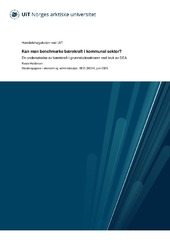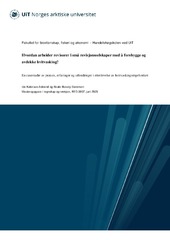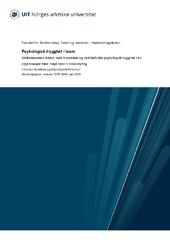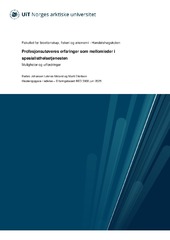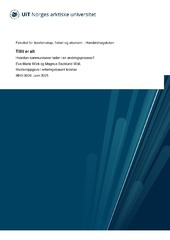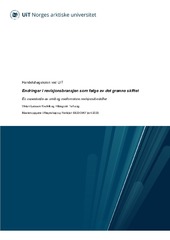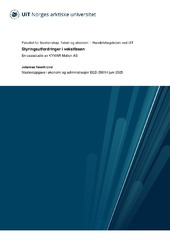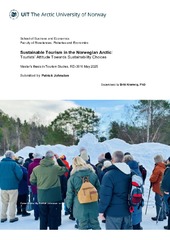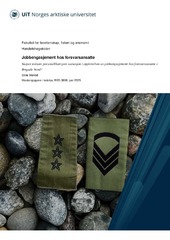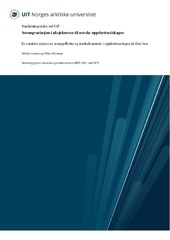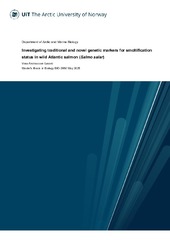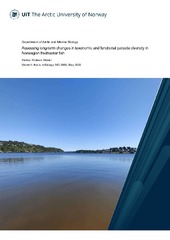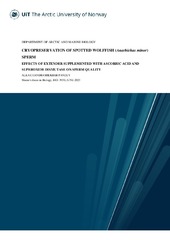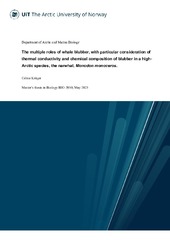Fakultet for biovitenskap, fiskeri og økonomi: Nye registreringer
Viser treff 61-80 av 5710
-
Hvordan fremme onboarding i kunnskapsbedrifter?
(Master thesis, 2025)Formålet med oppgaven var å undersøke hvilke fremmende faktorer som utgjorde en vellykket onboarding, med spesielt fokus på pre-boarding, og leders og nyansattes opplevelse av onboardingen. Problemstillingen var dermed «Hva fremmer en vellykket onboarding i kunnskapsbedrifter?». I dagens samfunn er det stadig økende fokus på hvordan onboarding kan skape et konkurransefortrinn. Ut ifra egne utfordringer ... -
Kan man benchmarke bærekraft i kommunal sektor?
(Master thesis, 2025)Målet med denne studien er å undersøke hvordan bærekraft kan måles i kommunal sektor, med et avgrenset fokus på grunnskolesektoren og Data Envelopment Analysis. Dette begrunnes i et behov for bærekraftig utvikling samt mangelen på måling av faktiske bærekraftsprestasjoner i kommunal sektor. Med utgangspunkt i den triple bunnlinje ble innholdet ved de ulike bærekraftsdimensjonene økonomi, sosialt ... -
Hvordan arbeider revisorer i små revisjonsselskaper med å forebygge og avdekke hvitvasking?
(Master thesis, 2025)Hvitvasking er et stort samfunnsproblem, og de siste årene har det blitt mer oppmerksomhet rundt hvordan ulike aktører i næringslivet i samarbeid med myndighetene kan bidra i kampen mot økonomisk kriminalitet. Revisorer har etter revisorloven plikt til å forebygge og avdekke økonomisk kriminalitet gjennom utførelsen av lovfestet revisjon og er også allmennhetens tillitsperson, som skal bidra til å ... -
Psykologisk trygghet i team
(Master thesis, 2025)I denne oppgaven undersøker vi hvordan mellomledere i en geografisk spredt organisasjon i olje- og gassbransjen arbeider med å bygge og opprettholde psykologisk trygghet i team som opererer i et miljø med høye krav til kontroll og sikkerhetsstyring. Med psykologisk trygghet mener vi et klima der ansatte føler seg trygge nok til å stille spørsmål, innrømme feil og dele usikkerhet, uten frykt for ... -
Hvordan opplever medarbeidere effekten av en planlagt organisatorisk endring?
(Master thesis, 2025)Hensikten med denne studien har vært å undersøke hvordan medarbeidere uten lederansvar opplever effekten av en planlagt organisatorisk endring i offentlig sektor. I motsetning til mange endringsstudier som setter søkelys på ledelsesperspektivet (endringsagenten), rettes oppmerksomheten i denne studien mot erfaringene fra medarbeidere som er berørt av endringen. Studien belyser derfor effekten av ... -
Profesjonsutøveres erfaringer som mellomleder i spesialisthelsetjenesten - Muligheter og utfordringer
(Master thesis, 2025)Målet med masteroppgaven har vært å studere hvordan leger og sykepleiere opplever rollen som mellomleder i spesialisthelsetjenesten. Vi har undersøkt hvordan deres profesjonsbakgrunn påvirker lederutøvelsen, og om de av samme grunn utøver ledelse ulikt. Videre har vi undersøkt deres motivasjon for å bli værende i rollen som mellomleder. For å undersøke dette har vi brukt følgende forskningsspørsmål: ... -
Ledelse av utviklingsarbeid i videregående opplæring - Lærernes erfaringer
(Master thesis, 2025)Sammendrag I denne case-studien undersøker vi lærernes erfaringer av ledelse av profesjonsfellesskap i videregående opplæring, i lys av relevant teori, empiri og skoleverkets lovverk og reformer. Vi ser nærmere på hvordan mål og forankring, organisering, tilrettelegging og lederstil kan påvirke lærernes motivasjon for skolebaserte utviklingsarbeid, og en mulig forbedret undervisningspraksis. Denne ... -
Tillit er alt. Hvordan kommuniserer leder i en endringsprosess?
(Master thesis, 2025)Tema for denne oppgaven er ledelseskommunikasjon. Formålet har vært å finne ut hvordan leder(e) i en valgt kommune benytter kommunikasjon som verktøy for å motivere og få med sine ansatte til å gjennomføre en endring. For å få til en slik endring er det nødvendig at alle ansatte, og da især mellomledere og nøkkelpersoner, forstår dagens situasjon og behovet for endring. Det er derfor viktig at lederne ... -
Endringer i revisjonsbransjen som følge av det grønne skiftet
(Master thesis, 2025)Denne studien har hatt som formål å undersøke hvordan små og mellomstore revisjonskontorer møter regulatoriske endringer som følger av det grønne skiftet. Innføringen av EUs CSRD med revisjonsattestering av bærekraftsrapporter fra og med regnskapsåret 2024, har dannet grunnlaget for studiens løp. Det har vært fokus på å studere revisjonskontorenes opplevelser, og ulike håndteringer i forbindelse med ... -
Barnevernsledelse: Fra nasjonale føringer til lokal kompetanseutvikling
(Master thesis, 2025)Sammendrag Bakgrunn: Det har i senere tid blitt gjort flere nasjonale tiltak for å øke kompetansen og kvaliteten i det kommunale barnevernet, blant annet er det kommet kompetansestrategi, utviklingstiltak, og kompetansekrav. Problemstilling: Hvordan jobber ledere i kommunale barnevernstjenester med å sikre kompetanse på individ- og organisasjonsnivå? Metode: Studien benytter kvalitativ metode med ... -
Styringsutfordringer i vekstfasen - En casestudie av KYMAR Motion AS
(Master thesis, 2025)Små og mellomstore bedrifter (SMB) spiller en avgjørende rolle i næringslivet, men møter ofte på utfordringer når de går inn i en vekstfase. Formålet med denne masteroppgaven har vært å undersøke hvilke styringsutfordringer en SMB står overfor i vekst, og hvordan økonomistyring, koordinering og kommunikasjon brukes som verktøy for å håndtere disse utfordringene. Jeg har tatt utgangspunkt i følgende ... -
Mellomleders forståelse av kontrollutøvelse i politiet
(Master thesis, 2025)Sammendrag Denne masteroppgaven undersøker kontrollutøvelse fra mellomleder til medarbeider i norsk politi. Studien utforsker mellomledernes forståelse av kontrollbegrepet og deres bruk av ulike kontrollelementer. Gjennom en kvalitativ tilnærming med bruk av semistrukturerte intervjuer, avdekker oppgaven at kontroll i stor grad forstås som rapportering og tilsyn, mens relasjonsbygging og verdibasert ... -
Sustainable Tourism in the Norwegian Arctic: Tourists’ Attitude Towards Sustainability Choices
(Master thesis, 2025)Arctic tourism has expanded rapidly, placing unprecedented pressure on fragile ecosystems and local communities. This study investigates tourists’ attitude towards sustainability in Tromsø of the Norwegian Arctic. Through a qualitative research design informed by the Theory of Planned Behaviour (TPB) and Social Practice Theory (SPT) the finding indicate that tourists hold pro-sustainability values, ... -
Lederpreferanser i mannsdominerte hierarkiske organisasjoner.
(Master thesis, 2025)Formålet med studien er å undersøke lederpreferanser i mannsdominerte hierarkiske organisasjoner. Studien gjennomføres i noen selskaper i byggebransjen, med overvekt fra selskapet HENT AS og tre militære avdelinger i Hæren. Studien kartlegger respondentene på følgende kriteria: kjønn, alder, bransje, hierarkisk posisjon, lederansvar og personalansvar. Basert på dette undersøkes respondentenes svar ... -
Jobbengasjement hos forsvarsansatte: Skaper militær personellkategori variasjon i opplevelsen av jobbengasjement hos forsvarsansatte i Brigade Nord?
(Master thesis, 2025)Målet med denne masteroppgaven har vært å undersøke hvorvidt det finnes forskjeller i opplevelse av jobbengasjement hos forsvarsansatte, basert på militær personellkategori; herunder om man er ansatt som offiser eller spesialist. Inspirasjonen til oppgaven er hentet fra Forsvarets medarbeiderundersøkelse (FMU) som ble gjennomført i 2023, der rapporten avdekket at 14 % av respondentene følte seg ... -
Sesongvariasjon i aksjekursen til norske oppdrettsselskaper
(Master thesis, 2025)Denne masteroppgaven undersøker hvorvidt det eksisterer sesongvariasjoner i aksjeavkastningen til børsnoterte norske oppdrettsselskaper. Oppdrettsnæringen utgjør en betydelig del av norsk eksport, og kjennetegnes av biologiske produksjonssykluser, sesongmessige prisvariasjoner og høy markedsvolatilitet. På tross av sektorens betydning og kompleksitet, finnes det lite forskning som direkte analyserer ... -
Investigating traditional and novel genetic markers for smoltification status in wild Atlantic salmon (Salmo salar)
(Master thesis, 2025)Atlantic salmon are anadromous fish, meaning they hatch and live their young lives in freshwater (FW), before migrating to seawater (SW) to feed and grow. The salmon must undergo physiological change to prepare for the new environment. This adaptation is called smoltification or parr-smolt-transformation (PST). One of the most obvious changes is the increasing salinity in SW. As the salmon migrates ... -
Assessing long-term changes in taxonomic and functional parasite diversity in Norwegian freshwater fish
(Master thesis, 2025)Climate change driven loss of biodiversity is occurring at an unprecedented rate, especially in vulnerable high-latitude freshwater systems. Despite the increasing recognition of parasites in ecosystems, there is a lack of long-term data on freshwater fish parasites, limiting our ability to understand changes in biodiversity of these important ecosystem players. This study investigates how freshwater ... -
CRYOPRESERVATION OF SPOTTED WOLFFISH (Anarhichas minor) SPERM EFFECTS OF EXTENDER SUPPLEMENTED WITH ASCORBIC ACID AND SUPEROXIDE DISMUTASE ON SPERM QUALITY
(Master thesis, 2025)The spotted wolffish (Anarhichas minor) holds considerable promise for cold-water aquaculture due to its high fillet yield, docile behaviour, and resistance to disease. However, reproductive constraints—including limited sperm motility, low ejaculate volume, and narrow spawning windows—impede large-scale hatchery production. Cryopreservation offers a strategic solution for overcoming these limitations ... -
The multiple roles of whale blubber, with particular consideration of thermal conductivity and chemical composition of blubber in a high-Arctic species, the narwhal, Monodon monoceros.
(Master thesis, 2025)Blubber in marine mammals is a multifunctional tissue, serving critical roles in thermoregulation, energy storage, endocrine regulation, and hydrodynamics. By providing insulation against cold, acting as a dense energy reserve, secreting hormones such as leptin to regulate metabolism, and streamlining the body for efficient swimming, blubber supports survival in diverse and often extreme environments. ...


 English
English norsk
norsk
